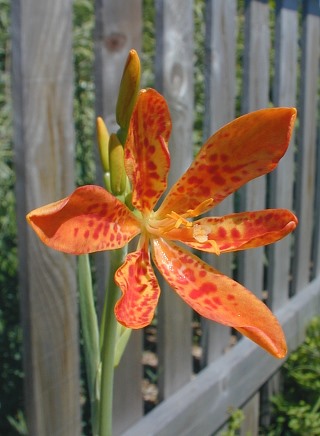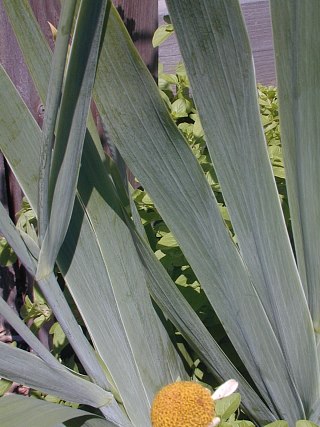 Description:
This perennial plant has sword-shaped alternate leaves about ¾–2'
long; they originate primarily toward the bottom of the flowering
stalk. These leaves are often grouped together into the shape of a fan;
they are green to grey-blue, linear in shape, glabrous, and glaucous.
Their margins are smooth, while their veins are parallel. The erect
central stalk is 2–3½' tall and either branched or unbranched; it is
terete, fairly stout, glabrous, glaucous, and pale green. This stalk
terminates in a cyme or compound cyme of flowers. There are pairs of
small linear-lanceolate bracts at each fork of the stalk; these bracts
are slightly membranous and tend to wither away. Each flower spans
about 1¼–2" across, consisting of 6 spreading tepals, 3 distinct
stamens, a style with a tripartite stigma, and an inferior ovary. The
tepals are orange with purple dots and elliptic-oblong in shape, while
the ovary is green, glabrous, and narrowly ovoid. Each cyme usually
produces several flowers. The blooming period occurs from mid- to late
summer and lasts about 1-2 months. There is no noticeable floral scent.
Each flower is replaced by an oblongoid seed capsule about 1" long; the
3 sides of this capsule become strongly recurved, revealing a mass of
shiny black seeds that resembles a blackberry. The root system consists
of a thickened crown at the base of the plant, which has fibrous roots
underneath; spreading rhizomes are also produced. Both the crown and
rhizomes have an orange interior. This plant can spread by either
rhizomes or seeds.
Description:
This perennial plant has sword-shaped alternate leaves about ¾–2'
long; they originate primarily toward the bottom of the flowering
stalk. These leaves are often grouped together into the shape of a fan;
they are green to grey-blue, linear in shape, glabrous, and glaucous.
Their margins are smooth, while their veins are parallel. The erect
central stalk is 2–3½' tall and either branched or unbranched; it is
terete, fairly stout, glabrous, glaucous, and pale green. This stalk
terminates in a cyme or compound cyme of flowers. There are pairs of
small linear-lanceolate bracts at each fork of the stalk; these bracts
are slightly membranous and tend to wither away. Each flower spans
about 1¼–2" across, consisting of 6 spreading tepals, 3 distinct
stamens, a style with a tripartite stigma, and an inferior ovary. The
tepals are orange with purple dots and elliptic-oblong in shape, while
the ovary is green, glabrous, and narrowly ovoid. Each cyme usually
produces several flowers. The blooming period occurs from mid- to late
summer and lasts about 1-2 months. There is no noticeable floral scent.
Each flower is replaced by an oblongoid seed capsule about 1" long; the
3 sides of this capsule become strongly recurved, revealing a mass of
shiny black seeds that resembles a blackberry. The root system consists
of a thickened crown at the base of the plant, which has fibrous roots
underneath; spreading rhizomes are also produced. Both the crown and
rhizomes have an orange interior. This plant can spread by either
rhizomes or seeds.
Cultivation:
The preference is full or partial sun, moist to dry conditions, and
soil that is loamy, rocky, or sandy. The flowers and foliage are rarely
bothered by disease or insect pests.
Range & Habitat:
Blackberry Lily has naturalized throughout Illinois in widely scattered
locations (see Distribution
Map). In the wild, it is uncommon, although its population
within the state may be increasing. Habitats include thin woodlands,
rocky bluffs, hillsides, fallow fields, roadsides, and sites of old
homesteads. Blackberry Lily was introduced from East Asia as an
ornamental plant and it is often cultivated in gardens because of the
attractive foliage and flowers.
Faunal Associations:
Very little is known about floral-faunal relationships for this
introduced plant. The flowers offer nectar and pollen to insects and
other floral visitors, but it unclear who these visitors are. There are
anecdotal reports that the seeds are eaten by birds.

Photographic
Location:
A flower garden at the Arboretum of the University of Illinois in
Urbana, Illinois.
Comments:
This remarkable plant has the leaves of an iris (Iris sp.),
the flowers of a lily (Lilium sp.), and a fruit that
resembles a blackberry (Rubus sp.). There is nothing
that quite resembles it. The flower of Blackberry Lily has only 3
stamens, while the flower of a lily has 6 stamens. The Blackberry Lily
differs from other members of the Iris family in having 3 distinct
stamens that are not petal-like in appearance. It is still unclear
whether the Blackberry Lily will become invasive. Another common name
of this species is the Leopard Lily.